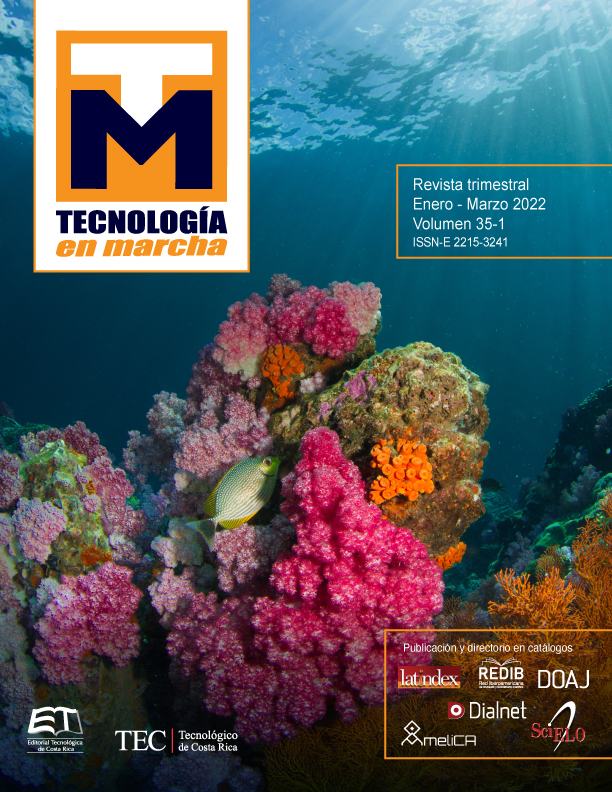Chemical risk assessment by applying an inherent safety index a case study in general chemistry teaching courses at a university center
Main Article Content
Abstract
The Inherent Safety (IS) has taken on great importance in recent years, allowing chemical risks to be assessed in order to eliminate or avoid hazards associated with physicochemical processes, by implementing additional protection in the various industrial streams as well as on smaller scale production process, like the chemical laboratories of university centers. The main objective of this research is to define the level of chemical risk present in General Chemistry experimental practices developed at university centers, by applying an inherent safety risk index. The risks of the chemicals were evaluated by obtaining physicochemical and toxic properties of the substances and their corresponding comparison with the sub-indices of the evaluation method of the inherent safety index, to finally obtain the Inherent Safety Index of the chemical (ICI) for each experiment. A total of 123 chemical reagents from 20 experimental procedures were evaluated, obtaining the highest ICI value (15) for the practices “Chemical reactions: chemical equations” and “Acid-base titrations”. In general, the level of risk according to the experimental values obtained from ICI for the evaluated laboratories are considered low, with values in a range between 2 and 15, compared to the maximum theoretical value (23) allowed by the methodology used.
Article Details

This work is licensed under a Creative Commons Attribution-NonCommercial-NoDerivatives 4.0 International License.
Los autores conservan los derechos de autor y ceden a la revista el derecho de la primera publicación y pueda editarlo, reproducirlo, distribuirlo, exhibirlo y comunicarlo en el país y en el extranjero mediante medios impresos y electrónicos. Asimismo, asumen el compromiso sobre cualquier litigio o reclamación relacionada con derechos de propiedad intelectual, exonerando de responsabilidad a la Editorial Tecnológica de Costa Rica. Además, se establece que los autores pueden realizar otros acuerdos contractuales independientes y adicionales para la distribución no exclusiva de la versión del artículo publicado en esta revista (p. ej., incluirlo en un repositorio institucional o publicarlo en un libro) siempre que indiquen claramente que el trabajo se publicó por primera vez en esta revista.
References
X. Gao, A. A. Abdul Raman, H. F. Hizaddin, and M. M. Bello, “Systematic review on the implementation methodologies of inherent safety in chemical process,” J. Loss Prev. Process Ind., vol. 65, no. March, p. 104092, 2020, doi: 10.1016/j.jlp.2020.104092.
S. N. H. Husin, A. B. Mohamad, S. R. S. Abdullah, and N. Anuar, “Chemical Health Risk Assessment at The Chemical and Biochemical Engineering Laboratory,” Procedia - Soc. Behav. Sci., vol. 60, no. May 2014, pp. 300–307, 2012, doi: 10.1016/j.sbspro.2012.09.383.
A. Heikkil, “Inherent safety in process plant design, Technical research center of Finland,” pp. 1–132, 1999.
M. Chen, “Process Safety Knowledge Management in the Chemical Process Industry,” Am. J. Chem. Eng., vol. 4, no. 5, p. 131, 2016, doi: 10.11648/j.ajche.20160405.16.
P. Wolkoff, S. T. Larsen, M. Hammer, V. Kofoed-Sørensen, P. A. Clausen, and G. D. Nielsen, “Corrigendum to ‘Human reference values for acute airway effects of five common ozone-initiated terpene reaction products in indoor air’ [Toxicol. Lett. 216 (2013) 54-64],” Toxicol. Lett., vol. 225, no. 3, p. 498, 2014, doi: 10.1016/j.toxlet.2014.01.016.
A. M. Flynn and L. Theodore, Health, Safety, and Accident Management in the Chemical Process Industries. 2002.
J. H. Ware et al., “Respiratory and Irritant Health Effects of Ambient Volatile Organic Compounds,” Am. J. Epidemiol., vol. 137, no. 12, pp. 387–416, 1993, doi: 10.31826/9781463230128-001.
H. B. B. Anuradha, M. Y. Gunasekera, and O. Gunapala, “Comparison of chemical routes based on inherent safety, health and environmental impacts of accidental and daily operational releases,” Process Saf. Environ. Prot., vol. 133, pp. 358–368, 2020, doi: 10.1016/j.psep.2019.11.001.
C. C. Ho and M. S. Chen, “Risk assessment and quality improvement of liquid waste management in Taiwan University chemical laboratories,” Waste Manag., vol. 71, pp. 578–588, 2018, doi: 10.1016/j.wasman.2017.09.029.
P. T. Anastas and D. G. Hammond, Inherent Safety at Chemical Sites: Reducing Vulnerability to Accidents and Terrorism Through Green Chemistry, vol. 16. 2015.
R. Rusli and A. Mohd Shariff, “Qualitative Assessment for Inherently Safer Design (QAISD) at preliminary design stage,” J. Loss Prev. Process Ind., vol. 23, no. 1, pp. 157–165, 2010, doi: 10.1016/j.jlp.2009.07.005.
S. Warnasooriya and M. Y. Gunasekera, “Assessing inherent environmental, health and safety hazards in chemical process route selection,” Process Saf. Environ. Prot., vol. 105, pp. 224–236, 2017, doi: 10.1016/j.psep.2016.11.010.
M. J. Jafari et al., “Exploring inherent process safety indicators and approaches for their estimation: A systematic review,” J. Loss Prev. Process Ind., vol. 52, no. February, pp. 66–80, 2018, doi: 10.1016/j.jlp.2018.01.013.
E. Rodriguez, M. Campinas, J. L. Acero, and M. J. Rosa, “Investigating PPCP Removal from Wastewater by Powdered Activated Carbon/Ultrafiltration,” Water. Air. Soil Pollut., vol. 227, no. 6, 2016, doi: 10.1007/s11270-016-2870-7.
Vargas, X., Benavides, C., Piedra, G., Syedd, R., & Rodríguez, J. (2015). Química Experimental: Un enfoque hacia la Química Verde. Pearson Madrid, España.
Carl Roth - International, 2020. [Online]. Disponible en: https://www.carlroth.com/com/en/. [Accesado: Mayo, 29, 2020].
LabChem Performance through chemistry, 2020. [Online]. Disponible en: https://www.labchem.com/. [Accesado: Mayo, 29, 2020].
Reactivos Química Meyer, 2020. [Online]. Disponible en: http://www.reactivosmeyer.com.mx/. [Accesado: Mayo, 29, 2020].
M. L. Williams, CRC Handbook of Chemistry and Physics, 76th edition.
F. Borgogno, Compendio de Propiedades Tabla de Entalpía de Formación, Energía Libre de Gibbs y Entropía de Formación de Compuestos Inorgánicos. 2010.
A. Saravia et al., “Programa Química General I Laboratorio I Ciclo 2020,” 2020.
M. Esquivel and J. Paniagua, “Programa Química General II Laboratorio II Ciclo 2019.” 2019.

